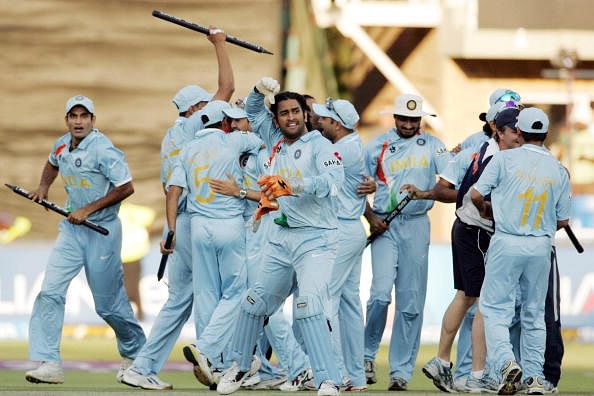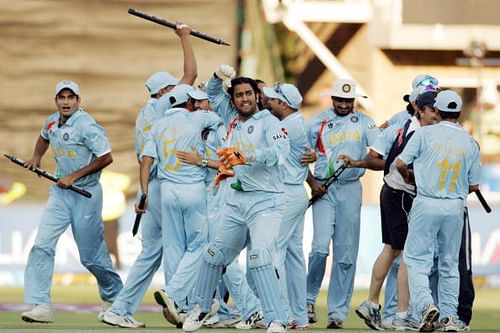
Indian cricket's finest moments

Growing up, cricket and tennis were the only two sports I religiously followed. The former by virtue of being an Indian and the latter because of personal interest. I distinctly remember my father calling home from office just to inquire about the score. Yes, that was the stone age when internet and mobile phones had not invaded our lives, but the excitement and enthusiasm surrounding cricket was still manic. Quite a few things have changed in this past decade – introduction of T20 cricket, a new breed of cricketers, retirement of stalwarts, etc. Quite a few things have not – Sachin is still God no matter how much we celebrate other sports, everything comes to a standstill when cricket is being played, and my dad still calls home from office to inquire about the score!
Although I am not a cricket expert, being a sports fan, I keenly follow most of India’s matches and thankfully, the team has given us a lot to cheer in the recent past. If I were to ask my parents about their favorite moments with respect to the Indian cricket team, the answers would predictably be the 1983 World Cup victory and the 1985 Champion of Champions win in Australia with the enduring image of Ravi Shastri driving a car in a sense symbolically telling the world that India had arrived in style. For me though, there are many others.
1. The Shirtless Sourav Moment
Up until this series, irrespective of how talented Indians were, the body language and the general attitude of dominance were missing. We walked the walk but seldom talked the talk, while it was the other way around for some of the other cricketing nations. The Natwest Series against England in 2002 was an important one. It was, in a sense, preparation for the 2003 World Cup, and the Indian team was coming off a series win in West Indies. In the finals, England put up 325 runs on the board; back in 2002, there were not many matches where runs in excess of 300 were scored. Given the fact that India’s performance in finals, especially overseas, was pretty terrible, to put it bluntly, no one would have given the Indians a chance. But buoyed by a good opening stand between Virender Sehwag and Sourav Ganguly, followed by two excellent knocks by then-newcomers Yuvraj Singh and Mohammad Kaif, the team got past the finish line with 3 balls to spare. What followed next was a jubilant celebration like no other. Taking one’s shirt off is not common in cricket. But never one to follow rules, Ganguly took off his shirt and waved it from the Lord’s balcony. That one moment, to me, defines the change in Indian cricket team’s attitude. It was the moment when the Indian team broke all shackles of their colonial hangover and started asserting themselves.
2. The T20 win in 2007
This one is perhaps fresher in all our memories. When the Twenty 20 World Cup started in 2007, people were not sure what to expect from it. Some dismissed it as trivial. Captain Mahendra Singh Dhoni, with his dyed hair and swashbuckling persona, was still an unknown entity. But as the tournament progressed, people’s interest grew. When India’s group stage match against Pakistan ended in a draw and went to a bowl out – the first of its kind – there was amusement and excitement. It reminded me of all those boys who play cricket on the streets and come up with innovative plays for fun. India defeated England and South Africa in the super 8s, with the former match containing the now-epic Yuvraj Singh’s six sixes in an over. In the semis it was India against Australia. Yuvraj Singh was in sublime form once again as India won the match by 15 runs to set up a final clash with arch rivals Pakistan. The world had to sit up and pay attention now. Suddenly, all news channels and papers were carrying articles on the tournament. I distinctly remember that I had an exam the day after the finals and all of us in the hostel were in two minds. We followed the score online from our rooms for a bit, but eventually could not resist going into the TV room to watch it. Who cares about exams when there is a World Cup to be won! 1983 to 2007 had been a long time waiting for the coveted trophy. It may not have been the traditional format but it gave all cricketing fans a lot to cheer and most importantly signified the rise of Captain Cool – Mahendra Singh Dhoni – who went on to lead India to further glory in the 2011 World Cup.
3. The Perfect Test match
Even 100 years from now, people will talk about this particular match. Perhaps one of the greatest Tests ever played, the second match of the Border-Gavaskar Trophy played in 2001 at the Eden Gardens in Kolkata was a display of talent, skill and resilience. Up against the great Australian side led by Steve Waugh, the Indian squad had lost the previous Test by 10 wickets. The same story repeated itself for the first two days in Kolkata, with the only bright spot being Harbhajan Singh’s hat-trick. India, in reply to Australia’s first innings score of 445, were bundled out for 171 runs – with only VVS Laxman managing a half-century – and were forced to follow-on. The batting then started showing some spine and India’s fortunes started to change. Laxman was once again the anchor, continuing from his solid 59 in the first innings to make a century with support from Rahul Dravid at the other end. But it was the 4th day of the Test that every Indian and perhaps every Test lover will remember. Laxman and Dravid batted out the entire day to build a 376-run partnership. India eventually declared, setting Australia a target of 384 runs on the fifth day. Although the achievements of both Laxman and Dravid were spectacular, a draw seemed like the most probable outcome at the start of Day 5. But a splendid burst of bowling by Sachin Tendulkar and a consistent display by Harbhajan Singh ensured a dramatic Australian collapse, giving India a 171-run win. Even today, the memories from that Test match bring a smile to every India cricket fan’s face. Victory was snatched from the jaws of defeat, and the sheer joy of seeing the Australians toil in the sweltering Bengal heat and looking helpless as Laxman and Dravid piled misery on them, makes this a very very special memory!
4. The birth of the ‘huddle’
Sourav Ganguly’s contribution to Indian cricket goes beyond his centuries and wickets. He instilled in the Indian team a spirit and a confidence that were a refreshing change from the previous teams that never asserted themselves in a way that the youth of the nation could identify with. The biggest representation of this was at the 2003 World Cup. India started off in unconvincing fashion, barely managing to get past minnows Netherlands and suffering a humiliating defeat against Australia. The backlash was severe. People in India burned effigies and wrote the team off. Any previous Indian team would have perhaps carried on without making any significant statement of intent. But this team was different. India went on to win all of its next 8 matches and that too with match-winning contributions across the team. The team lost only two matches throughout the tournament, and both were to the eventual champions Australia. The ‘huddle’ that became a customary part of the celebration on the ground was a symbol fans back home related with. India had turned from a group of brilliant individuals strung together to an actual team. Though the final was a disappointment, the 2003 World Cup campaign was a major step in the right direction for India.
5. When Venkatesh Prasad showed “who’s the boss”
Perhaps not as significant as the other moments on this list, this still remains one of the coolest moments ever for me in Indian cricket. Venkatesh Prasad was a good bowler albeit not as great as Kumble or Srinath, but this moment is what people will remember him for more than his bowling records. India-Pakistan matches are always high on drama. Tensions run deep and people’s expectations from their respective teams reach unreasonable limits. In 1996, in the World Cup quarterfinal against Pakistan at Bangalore, the situation was no different. After putting 287 runs on the board on the back of a splendid 93 by Navjot Singh Sidhu, Pakistan got off to a great start. Aamir Sohail hit Prasad for a boundary in the 15th over and in an unprofessional gesture, went up to him pointing his bat towards the boundary. It did not take a genius to connect the dots. Instead of saying or doing anything, Prasad went back to bowl the last ball of his over. He came running and knocked Sohail’s stumps in a fitting reply. You do not have to be aggressive in your body language to be aggressive in your cricket. Prasad taught us all and most importantly, the then Pakistani cricket team captain, that it is never good to be on the wrong side of a fast bowler.
I chose not to include the 2011 World cup victory because it is both obvious and overdone. These moments were in large part from my childhood and teenage years – the 90s and 2000s, when Indian cricket was transitioning and gave us great heroes. This era set the foundation for the current team to build upon and go forth to achieve several more accolades. Even without the razzmatazz that we have now become accustomed to as a package deal with cricket, these memories define the Indian cricket team for me.